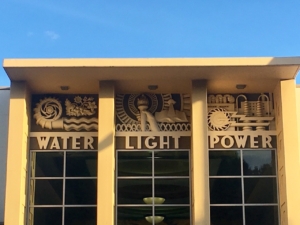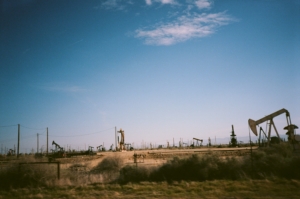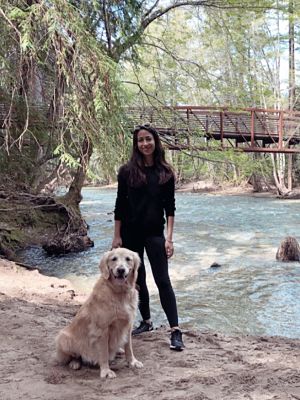The Ripple Effect
I’ve been fascinated with water conservation since before I could see over the bathroom sink. While my mother was brushing her teeth, if the tap was still running, I’d stand on my tiptoes and twist the faucet shut.
“Wasteful,” I‘d say. She’d look at me with a foamy half-smile and spit into the basin. Or if she took a shower for a minute too long, I’d stand with two gummy palms pressed against the steaming glass door.
“Wasteful,” I’d say, jolting her wet silhouette.
* * *
Getting out of my car, I stretch my legs at a gas station in Lost Hills, a rather humid stretch of central California farmland—somewhere between the sweeping coastal cliffs of Big Sur, where I have just spent the last few days hiking the lustrous terrain and flicking tics off my golden retriever, and Los Angeles, my hometown. After the rain season, everything is covered in a green sheen—even my car’s windshield, decorated with insect casualties.
After I shuck the winged barnacles off with a squeegee, I dust corn nut residue off my pants and bend down to fish through the dredges of the filthy car’s floor. As I hover over the trash can, both arms now filled with empty plastic water bottles, I see a sign in the intersection that reads:
“Is Growing Food a Waste of Water?”
Past the sign, two vastly different strips of land flank the highway. The left side is a utopia of lush trees sprinkled in dew as far as the eye can see, while across the street, the land is brown and bald and never ending.
* * *
Sixty years ago, California governor, Edmund Gerald “Pat” Brown, spearheaded The State Water Project, which moved billions of gallons of water from the wet Northern Sierras to the dry south, using various dams, pumping stations and a 400-mile-long man-made river. The relocation of California’s water has helped shaped the growth of two iconic cities, San Francisco and Los Angeles, as well as the nation’s most fertile farm belt. In 2016 alone, 76,700 farms operated over 25.4 million acres in California, receiving an annual profit of $46.04 billion. But underneath the surface of fragrant nut trees and storybook vineyards, something ugly stirs.
 In order to sustain the suburban and agricultural demands, resident farmers—and mainly conglomerate corporations—have resorted to trading in water. Not master paintings, but water is bought and sold—largely by and to the highest bidder.
In order to sustain the suburban and agricultural demands, resident farmers—and mainly conglomerate corporations—have resorted to trading in water. Not master paintings, but water is bought and sold—largely by and to the highest bidder.
In 1995, one corporate landowner, Stuart Resnick of Paramount Farms (more commercially known as The Wonderful Company), gained 58% control of the Kern Water Bank for around $30 million from the state in a legal, but questionable agreement. Behind closed doors and finalized without the community’s input, The Monterey Agreements attempted to settle disputes between contractors of the State Water Project and irrigation districts in the southern San Joaquin Valley. Since then, Resnick has doubled production and is the biggest growers of almonds, pistachios and pomegranates in the country, with a personal net worth of $4.2 billion dollars.
One study estimates that the totality of The Wonderful Company’s crops consume more water annually than all of the homes in the city of Los Angeles.
All of them.
* * *
For as long as I can remember, I have found solace in the outdoors—as a child, I recall pushing aside unruly, tangled hair to overturn rocks in my Southern Californian backyard, revealing their damp underbellies and the teeming rollie-pollie bugs underneath, with their artillery bodies hardening into balls. I carried them inside careful, sticky hands, hurdling through the tall grass and took shelter beneath the weeping willow tree, coaxing them to unfurl.
“What do you have there?” my mother’s faint English accent questioned—a California transplant, whose willowy form was outlined by the dangling green ornaments. I showed her my bounty: an open palm filled with scattering bug bodies, my mouth spread wide into a toothy smile, riddled with blank pockets where my baby teeth used to be.
“Can I keep them?”
She took me by the bugless hand, lovingly yanking me up and out through the leafy curtain. I followed the backs of her combat boots, traversing displaced stones and decomposing lemons, rogue tennis balls and clumps of knotted weeds into a clearing where uniformed rows of my mother’s garden roses snaked towards a blistering sky.
It was there I returned the bugs to the basin of the thorny stalks, where the cracked earth concealed the torrent of roots beneath it.
* * *
Across the highway, on the brown side, one thousand residents in East Porterville had no running water for two years due to California’s unrelenting droughts. As a result, families washed their hands and dishes with bottled water. They searched for places to shower on Craigslist. Though their water has since been connected, through a series of staggered emergency phases, water bills have quadrupled to upwards of $54, while the water itself is completely undrinkable.
 To make matters worse, in neighboring Kern County, contaminants were discovered in 117 public wells in 2016. High levels of 1,2,3-TCP, a cleaning solvent and cancer-causing chemical associated with pesticide products, tested positive throughout.
To make matters worse, in neighboring Kern County, contaminants were discovered in 117 public wells in 2016. High levels of 1,2,3-TCP, a cleaning solvent and cancer-causing chemical associated with pesticide products, tested positive throughout.
The larger issue in Kern County involves the pumping of groundwater—an unenforced activity with even greater consequences. Aquifers, a body of permeable rock that can contain and transmit water, keep the structure intact; when you pull the water out, the outer layer compresses and the ground subsides, sinks. Landowners like The Wonderful Company are sucking the resources out of the ground, even if it belongs to their neighbors, leaving many farmers and homeowners with nothing besides dry, crumpled, unworkable land.
The Sustainable Groundwater Management Act (SGMA) of 2014 is a legislative statute signed by Governor Jerry Brown (son of “Pat”) to regulate, enforce and change the dynamic of pumping water. Unfortunately, it will not be implemented for another twenty years.
* * *
I arrive home as the sun dips, tired from the drive. Deer skim the distant, grassy hillside. The next-door neighbor’s tree hulks over the front deck—leaves like catcher’s mitts stockpile in the circular pool’s center, clouding its hue like an eye gone blind.
Inside, I greet the two basil plants in glass cups over the kitchen sink. One is jaundice and paltry; clings on. The other bursts with abandon, projecting a widespread peppery scent. Still, I water the sickly one, prune its speckled, flaking leaves and thumb its limp stalk straight, as if to will it into its counterpart. I bring it out back to revive it.
After I attach the hose’s valve to the spigot, turn the handle and feel the churning water billow, forming a peristaltic wave—I drag it over to the small herb bed and baptize the wicked rosemary, sophisticated mint, velvety sage and the rows of blinking, cheery chamomile. Honeybees undulate amongst the tall weeds. My hands scoop the wetted earth and tuck the wilting basil plant inside—wishing it luck. Then I clip a couple roses from their tangled stems, holding the stalk underneath the fleshy bud, where my mother has taught me there aren’t any thorns.
The benefits of mother nature come without cost and we have a responsibility to protect and preserve them from those who weigh profit over human rights. We must become more mindful of what we waste.
Though most of my childhood backdrop remains: my mother’s garden roses, the splintered jungle gym, rollie-pollie bugs somersaulting past tennis balls, an empty space has replaced my shady sanctuary. The weeping willow tree has since died—roots rotted from insufficient drainage.
But will any of this matter when there isn’t any water left?
As I drop the roses into a vase, the retriever laps from her bowl in rhythmic clicks. She looks up at me with a glistening nose, paints the kitchen floor with droplets. Parched as well, I open the refrigerator door and past the canned roasted red peppers, marinating artichoke hearts, cornichons, Greek pepperoncinis, pasture-raised organic eggs, corn tortillas and strawberry jam, is a clear bottom shelf, sanitized in translucence and lined with dozens of:
One-liter plastic water bottles.
Brand, Fiji.
Product of, The Wonderful Company.
 Lily Semel is currently working towards her MFA in Creative Writing at Antioch University in Los Angeles, where she was born and raised. She serves as Co-Lead CNF Editor at Lunch Ticket. She no longer drinks Fiji water. Her mother, Jane, is replanting the weeping willow tree.
Lily Semel is currently working towards her MFA in Creative Writing at Antioch University in Los Angeles, where she was born and raised. She serves as Co-Lead CNF Editor at Lunch Ticket. She no longer drinks Fiji water. Her mother, Jane, is replanting the weeping willow tree.





